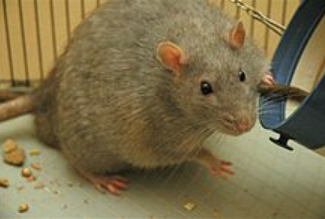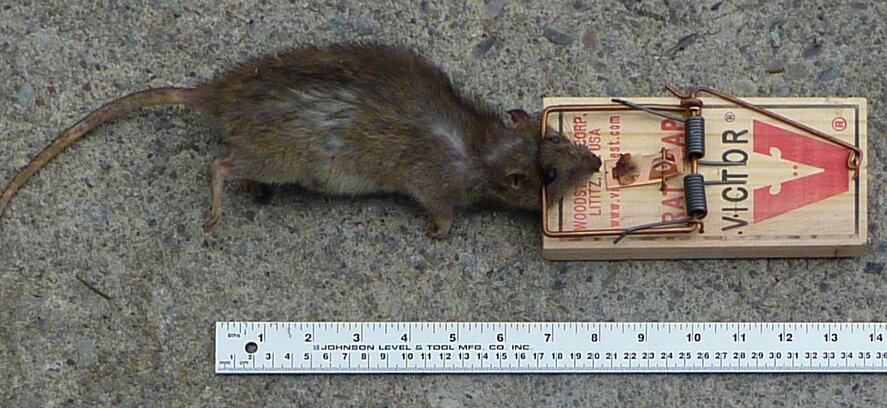
Rats carry diseases, make a mess and can destroy parts of your home. If you see evidence of rats around your house, you need to trap them.
To trap rats in your home, choose a snap, electric or a live trap. They should be set along walls where you have seen rats. Select the best bait to attract rats to your trap, with peanut butter being a top choice. It may take a few days to figure out the best location, bait or for the rats to learn to trust the traps. After you trap the rats, you must dispose of them.
With a little effort, you can trap rats in your home. For an in depth look at how, read these techniques I have learned from my years as a pest control professional.
You may also be interested in reading these two related articles “How To Safely Handle Mice and Rat Droppings” and “How To Get Rid Of Squirrels“.
Signs Of Rat Infestations
Before setting up a bunch of traps, be sure you have a rat problem. There are a few signs that you have a rat infestation in your home, including:
- Odd Sounds and Smells – Rats smell like ammonia and make scratching, squeaking and rustling noises.
- Droppings and Smears – Rat poop looks like 1/2 to 3/4 inch dark pellets. Smears are greasy streaks left by the rat’s body as it moves along your walls.
- Tracks – Rat footprints are 3/8 to 3/4 of an inch long, with four widely-spaced toes in the front and five in the back feet.
- Damages – Rats may chew furniture, gnaw on electrical chords, rip through garbage bags or eat food left out overnight.
Best Rat Traps

There are several effective methods of trapping rats in your home. The three most common that you can choose from include:
- Snap Traps – These are the traps you might think of from cartoons, which are a spring-loaded bar on a small board that trips when a rat grabs the bait. While these traps are a proven method, sometimes they miss the rat, injuring it before a slow death or recovery to bother you again.
- Electric Traps – This trap lures rats in, then delivers an electric shock to kill them. Electric traps might be the most humane method of killing rats.
- Live Traps – For this trap, rats are lured into a cage that closes after they enter. Then you can take the rat to a safe place to free it.
Lethal traps are the best option for urban or suburban rats. They aren’t likely to survive in the wild, and cause many problems if freed near other humans.
Homemade Rat Trap
An effective rat trap can be made with a few items you might have around the house. For this rat trap, you will need:
- A five-gallon plastic bucket
- A metal rod that extends across the top of the bucket
- A plastic bottle
- A board that reaches from the ground to the top of the bucket at a low slope
- Peanut butter
The steps to make the trap are:
- Cut two 1/4 inch notches in the top of the bucket across from each other that the rod fits snugly into.
- Take the top off the plastic bottle and cut a small hole in the bottom for the rod to go through.
- Stick the rod through the bottle, and place the ends of the rod into the notches in the bucket so the bottle can spin on the rod.
- Smear peanut butter around the plastic bottle.
- Place the board as a ramp to the top edge of the bucket.
This trap works because the rat will climb the ramp to eat the peanut butter, then step on the bottle, which will spin on the rod and send the rat to the bottom of the bucket. The rat won’t be able to climb out of the five-gallon bucket.
That rat won’t die in the trap, and you can release it somewhere far away from your home. If you want to kill the rat, fill the bucket half full of water, and the rat will drown.
Where To Set Rat Traps
Rats typically travel along walls, using the surface as a guide and for protection. Therefore, next to walls is the best location for setting rat traps.
Furthermore, place traps next to the walls near where you have noticed their activity. Also, rats like to stay in low-light areas. This fact makes traps set in closets or under furniture more effective.
On the other hand, traps set in the middle of the room or in lighted areas are less likely to catch rats. In the end, you may need to try several locations before you find the best place to catch rodents.
Positioning Rat Traps
Set rat traps perpendicular to walls, with the baited trigger closest to the wall. Also, leave 15 feet between traps.
If you don’t have space to put your traps at a 90-degree angle with the wall, place two traps next to each other, with triggers facing out. This positioning makes it more likely the rat will come across the trapping end rather than setting it off without getting trapped.
How Many Rat Traps Should I Use?
One or two well-placed traps should be enough to catch a single rat in your home. Multiply the number of rats by two to find the number of traps you need for larger infestations.
What Is The Best Bait For Rat Traps?
First, identify which food source the rat eats. Using the same food the rats are accustomed to could be the perfect way to lure them into your trap.
Overall, the smellier the bait, the more attractive it is to rats. Moreover, pungent food is more likely to catch rodents.
Next, if you can’t figure out what the rats eat, identify what type of rat. The two most common types of rats in North America are brown rats and black rats:
| Rat Type | Color | Length | Weight | Tail Length | Body | Eyes | Lifespan | Droppings | Diet |
| Brown Rat | Reddish brown to grayish brown | 7 to 10 inches | 10 to 16 ounces | Shorter than body length | Thick body with blunt nose | Black, big and protruding | 5 to 12 months | Grouped together; Blunt ends and ¾ inch long | Omnivores |
| Black Rat | Black to brownish gray | 6 to 12 ounces | 6 to 8 inches | Longer than body length | Slender body and pointed nose | Prominent eyes | 5 to 18 months | Scattered; Pointed ends ½ inch long | Herbivores |
Baiting Brown Rats
Brown rats (Norway rats) are omnivorous and often root through garbage cans. The best baits for brown rats are:
- Peanut butter
- Cheese
- Hot dogs
- Gum drops
- Chocolate
- Bacon
- Nesting materials (string, dental floss, twine
Norway rats enter most homes through cracks or holes in the foundation or siding. They build their nests in sewers, in burrows in the ground, or in lower levels of buildings and basements.
Baiting Black Rats
You might know these critters as roof rats. They prefer eating in elevated areas. The best baits for black rats are:
- Nuts
- Peanut butter
- Berries
- Dried fruit
- Nesting materials
Roof rats nest in attics, chimneys, behind walls and above ceilings. In that vein, they enter homes by crawling along tree branches or other brush onto roofs.
What If Rats Steal The Bait Without Setting Off The Trap?
Rats are smarter than they look and might be able to eat your bait without triggering your trap. Therefore, make your bait hard to get off the trap to make sure you catch the rat.
Luckily, peanut butter is a potent rat bait, it’s cheap and sticks to the trap well. Smear some on your trap trigger, and rats won’t be able to eat without setting it off.
If you don’t have peanut butter, don’t worry. You can tie your bait onto the trigger, and that should be just as effective.
What If Rats Won’t Go Near My Traps?
Rats fear new things, so setting a baited trap might make them wary. You might need to acclimate the rats to the traps before you can catch them.
To acclimate rats to traps, leave them out for a few days unset but baited. The rats will start to eat from the traps and trust them over this time.
After the acclimation period, set the traps with bait. The rats will be caught off guard, and you will catch them easily.
Should I Use Poison Bait For Rats?
Poison bait is not a good way to get rid of rats in your home. An instant death like from a snap or electric trap is always preferred.
A poisoned rat won’t die right away and could be hard to locate afterward. This could spread the poison to other parts of your home, to your pets or to children.
Also, if a poisoned rat dies in a hard-to-reach location, such as inside a wall, its carcass will rot and stink up your home for months. Your job isn’t done if you kill the rat; you have to deal with its body, too.
What To Do After Trapping Rats
After the rat is trapped, put its carcass into a plastic bag, seal it and throw it in the trash. Always wear rubber gloves when you handle rats or traps.
Clean the trap and the area where the rat died with diluted bleach. After the trap is cleaned and dry, you can set it again, store it to use later, or give it to someone who can use it.
Give your house a deep cleaning, making sure to eliminate all signs of rats. Ensure no more rats are in your home, then seal possible entrances.